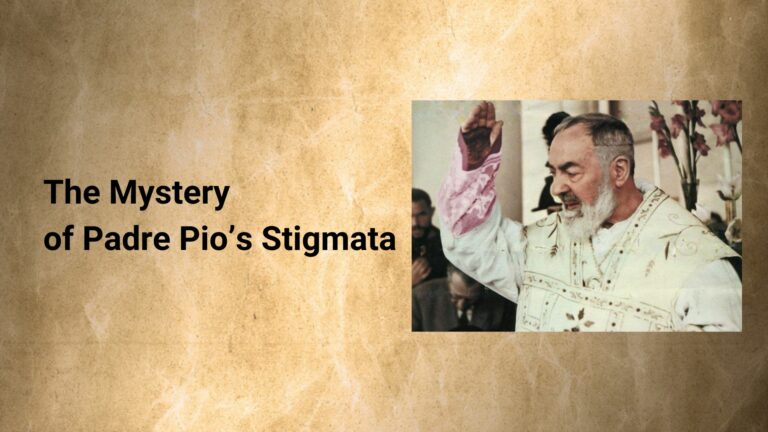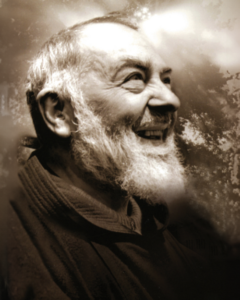
Padre Pio, a Capuchin friar, mystic, and miracle worker, remains one of the most intriguing figures in modern Catholic history. His life, marked by extraordinary phenomena such as bilocation, healing miracles, and above all, the stigmata, continues to inspire devotion. Among these remarkable aspects, his stigmata—the wounds that mirrored those of Christ’s crucifixion—are perhaps the most widely discussed and scrutinized. This article delves into the events surrounding Padre Pio’s stigmata, how they were examined, and the findings that left the world in awe.
The Beginning of Padre Pio’s Public Fame
In 1919, a newspaper article catapulted Padre Pio to fame, detailing miraculous healings and his visible stigmata. The ecclesiastical authorities had no choice but to address the growing public interest. To investigate the matter, they sought the expertise of Professor Amico Bignami, a respected medical doctor who was, notably, an atheist. His atheism was considered an asset; his lack of religious belief would, in the Vatican’s view, ensure an unbiased examination of the friar’s wounds.
Bignami accepted the task but insisted that his involvement remain confidential, fearing for his professional reputation. Despite this request, his examination of Padre Pio in San Giovanni Rotondo in July 1919 would become one of the most well-documented investigations into the mystic’s stigmata.
The Medical Examination
Professor Bignami’s report is a fascinating piece of medical history. Upon first encountering Padre Pio, he described the friar as frail, pale, and of sickly appearance, yet noted that despite his weak constitution, Padre Pio displayed an extraordinary endurance. For example, the friar was known to hear confessions for up to 16 hours at a time without resting or eating, a feat that baffled the doctor. But it was the stigmata themselves that held the most significance.
The wounds on Padre Pio’s hands, feet, and side mirrored those of Christ’s crucifixion, a phenomenon that had been reported in the Church’s history among mystics but had rarely been subject to thorough medical scrutiny. Bignami observed the wounds in detail and formulated three possible explanations:
- The wounds were self-inflicted: Bignami quickly dismissed this hypothesis. He found no evidence to suggest that Padre Pio had deliberately caused harm to himself.
- The stigmata were a result of a medical condition: The doctor considered the possibility that the wounds were symptoms of a psychosomatic or neurotic condition. While he acknowledged that they resembled necrotic skin lesions seen in such cases, this did not explain their perfect symmetry and their persistence over time.
- A combination of natural and artificial factors: The final hypothesis was that while the wounds might have initially formed naturally, Padre Pio could have unconsciously kept them open. This was plausible, given that the friar was known to use iodine to treat his wounds—although this was common knowledge and not seen as a form of self-harm.
Despite this thorough examination, Bignami’s conclusions remained inconclusive. The scientific community found no clear explanation for the stigmata, leaving the door open to both skepticism and belief.
The Experiment: Sealing the Wounds
In an effort to put the matter to rest, Bignami devised an experiment. He ordered the wounds to be bandaged with clean gauze daily under strict supervision. The bandages were sealed, ensuring that neither Padre Pio nor anyone else could tamper with them. The expectation was that if the wounds were being artificially maintained, they would begin to heal once left alone.
For eight days, three friars carried out this task under the supervision of the Father Guardian, closely following Bignami’s instructions. What happened during this time astonished everyone. Not only did the wounds fail to heal, but on the final day, while Padre Pio was celebrating Mass, his hands bled so profusely that cloths had to be brought in to absorb the blood.
Witnesses to the Phenomenon

The friars involved in the bandaging of Padre Pio’s wounds provided written testimonies of what they witnessed. Three of the four friars confirmed that throughout the eight-day period, the condition of the wounds remained unchanged, save for the last day, when the bleeding intensified. They attested that no medicines were applied to the wounds, and all possible sources of contamination—such as the iodine Padre Pio occasionally used—were removed from his room.
One friar specifically noted that he had never seen the wounds bleed as much as they did during this period. This testimony further cemented the view that something extraordinary was at play—something beyond the reach of medical science.
The Impact of Padre Pio’s Stigmata
Professor Bignami’s findings were not enough to provide a definitive explanation for Padre Pio’s stigmata, but they were significant in that they ruled out deliberate fraud. The Vatican took Bignami’s report seriously, but the mystery remained unresolved, leaving room for continued debate among believers and sceptics alike.
In later years, one of the friars involved in caring for Padre Pio remarked that, even decades after the initial examination, the wounds had not healed. Padre Pio lived with his stigmata for 50 years, bearing this visible sign of Christ’s suffering until his death in 1968.
A Spiritual Reflection on the Stigmata
While science attempted to explain Padre Pio’s stigmata, for many, the wounds were a profound sign of his deep connection with Christ. The stigmata represent the ultimate imitation of Christ, sharing in His physical suffering as a way to bring souls closer to God. Reflecting on these wounds can serve as a powerful spiritual exercise for anyone seeking a deeper connection with Christ.
Saint Francis de Sales, a Doctor of the Church, encouraged meditation on Christ’s Passion as a means to grow in patience and virtue. By contemplating the wounds of Jesus—whether through mystical experiences like Padre Pio’s or through personal reflection—we can deepen our appreciation of His love and sacrifice for humanity.
Conclusion
The story of Padre Pio’s stigmata is one that continues to inspire awe and devotion. Despite scientific scrutiny, the wounds remained a mystery, defying explanation and pointing to the possibility of divine intervention. Whether viewed through the lens of faith or science, Padre Pio’s life and his visible suffering call us to reflect more deeply on the mysteries of God’s love and the sacrifice of Christ.
For those looking to enrich their spiritual journey, contemplating the Holy Wounds of Our Savior, Jesus Christ, can be a powerful way to foster a closer relationship with Him, just as Padre Pio did throughout his remarkable life.

